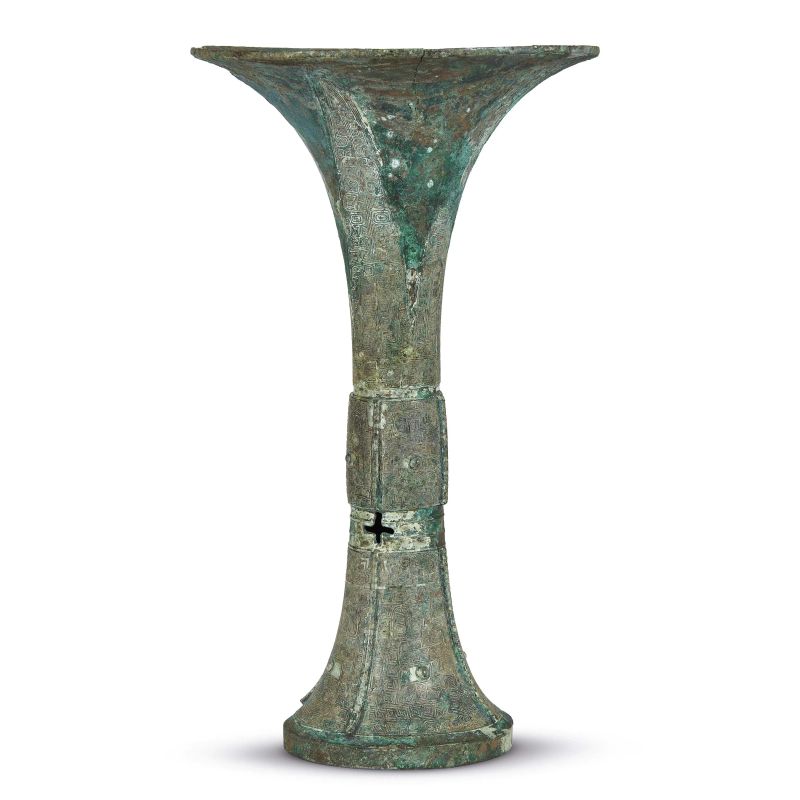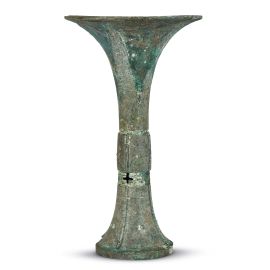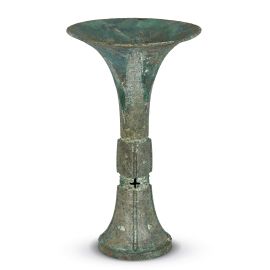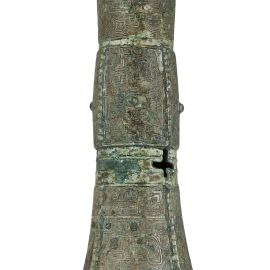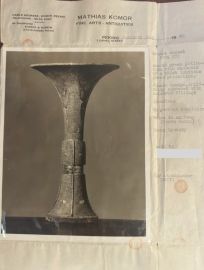A RITUAL BRONZE VASE (TYPE GU), SHANG DYNASTY (1600-1046 B.C.)
An elegant Chinese ritual bronze vase, of the slender and distinctive Gu type. The elongated body opens into a wide flared mouth, decorated with stylized motifs and engravings typical of the bronze art of the time. The natural green patina, conferred by the oxidation process, enriches its historical and artistic value. In ancient times, it was used to hold wine or liquids during ritual ceremonies.
Height: 29 cm
The Gu is a vessel for drinking wine. In the Shuowen Jiezi, section Jiao, it is written: "The Gu is a vessel for drinking wine during village banquets; it is also said that a vessel that holds three sheng is called Gu." In ancient texts, Gu and Zhi are often confused. The term Gu, as we understand it today, derives from the classification given by Song dynasty scholars, without definitive proof identifying it as the Gu mentioned in pre-Qin texts. Objects similar to this one discovered so far do not bear a specific name but can reasonably be considered wine-drinking vessels based on their form. In the early Shang dynasty, some Gu had a partially covered opening and a spout, which directly indicates their use as drinking vessels. The Shang people, great lovers of wine, were closely tied to the complex structure of their religious ceremonies, which is why they devoted great care to the production of wine vessels.
This late Shang dynasty Gu features a wide mouth, a slender and long neck, a slightly rounded belly, and a tall, flared circular base, with a prominent lower rim. The neck is smooth and undecorated, while the belly displays two raised bands and an animal mask decoration formed by inverted dragon motifs. At the base of the belly and at the connection to the foot, there are two decorative lines and a cross-shaped decorative hole. The foot is adorned with four groups of inverted dragons, and the empty spaces are filled with cloud and thunder patterns, harmoniously arranged in large and small shapes.
商晚期 青铜兽面纹觚 高 29 厘米
觚为饮酒器,《说文•角部》:“觚,乡饮酒之爵也;一曰:觞受三升者谓之觚。”解释:“觚,是用于乡饮酒的爵器;也有说法称容量为三升的觞为觚。”在古籍中,觚和觯常常被混淆。现代称呼的“觚”其实沿用了宋代学者的考证之名,并没有确凿证据证明它就是先秦文献中的觚。目前发现的此类器物并无确切名称,但从形态上基本可以认定其为饮酒器。
商代早期的觚有时在口部部分封闭,并带有流,这直接证明了其作为饮具的功能。商人嗜酒,这与其复杂的祭祀制度息息相关,因此对饮酒器的制作也极为考究。这件商代晚期的兽面纹觚,敞口,细长颈,腹部微鼓,圈足高且外撇,下部有一圈突出的边沿。颈部光滑无纹,腹部有两条突起,并以倒立龙纹组合成兽面纹。腹部与圈足相接处饰有两道弦纹,另有装饰性的十字孔。圈足上也装饰了四组倒立龙纹。所有空隙处以云雷纹填充,大小相间,排列有序。
VASO RITUALE IN BRONZO TIPO GU, DINASTIA SHANG (1600-1046 A.C.)
Elegante vaso rituale cinese in bronzo, di forma slanciata e distintiva del tipo Gu. Il corpo allungato si apre in un’ampia bocca svasata,decorata da motivi stilizzati e incisioni tipiche dell’arte bronzistica dell’epoca. Patina verde naturale conferita dal processo di ossidazione, che ne arricchisce il valore storico e artistico. Utilizzato in antichità per contenere vino o liquidi durante le cerimonie rituali.
Alt. cm 29
Il Gu è un recipiente per bere vino. Nel Shuowen Jiezi, sezione Jiao, si legge: "Il Gu è un recipiente per bere vino durante i banchetti di villaggio; si dice anche che un recipiente che contiene tre sheng sia chiamato Gu." Nei testi antichi, il Gu e lo Zhi spesso si confondono. Il termine Gu, così come lo intendiamo oggi, deriva dalla classificazione data dagli studiosi
della dinastia Song, senza prove definitive che lo identifichino con il Gu delle opere preQin. Gli oggetti simili a questo rinvenuti finora non portano un nome proprio, ma possono essere ragionevolmente considerati come recipienti per bere vino sulla base della loro forma. Nella prima fase della dinastia Shang, i Gu avevano a volte un'apertura
parzialmente coperta e un beccuccio, una caratteristica che ne prova l’uso come
recipiente per bere. Gli Shang, grandi amanti del vino, erano strettamente legati alla complessa struttura delle loro cerimonie religiose, motivo per cui dedicavano molta cura nella produzione di recipienti per il vino. Questo Gu della tarda dinastia Shang presenta un'imboccatura ampia, un collo sottile e lungo, un ventre leggermente bombato e un piede circolare alto e svasato, con un bordo alto nella parte inferiore. Il collo è liscio e privo di decorazioni, mentre il ventre presenta due rilievi e una decorazione a maschera animale, formata da motivi a drago rovesciati. Alla base del ventre e nel punto di connessione con il piede, sono presenti due linee decorative e un foro decorativo a forma di croce. Il piede è ornato con quattro gruppi di draghi rovesciati e le aree vuote sono riempite con motivi a nuvola e fulmine, in un insieme armonioso di forme grandi e piccole, disposte in modo ordinato.
觚为饮酒器,《说文•角部》:“觚,乡饮酒之爵也;一曰:觞受三升者谓之觚。”解释:“觚,是用于乡饮酒的爵器;也有说法称容量为三升的觞为觚。”在古籍中,觚和觯常常被混淆。现代称呼的“觚”其实沿用了宋代学者的考证之名,并没有确凿证据证明它就是先秦文献中的觚。目前发现的此类器物并无确切名称,但从形态上基本可以认定其为饮酒器。
商代早期的觚有时在口部部分封闭,并带有流,这直接证明了其作为饮具的功能。商人嗜酒,这与其复杂的祭祀制度息息相关,因此对饮酒器的制作也极为考究。这件商代晚期的兽面纹觚,敞口,细长颈,腹部微鼓,圈足高且外撇,下部有一圈突出的边沿。颈部光滑无纹,腹部有两条突起,并以倒立龙纹组合成兽面纹。腹部与圈足相接处饰有两道弦纹,另有装饰性的十字孔。圈足上也装饰了四组倒立龙纹。所有空隙处以云雷纹填充,大小相间,排列有序。

